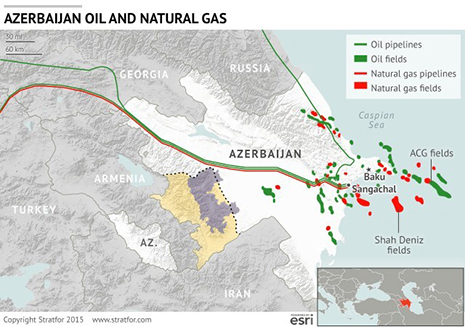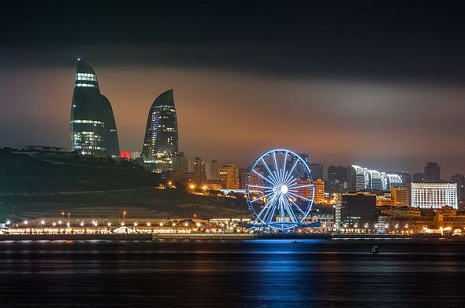The Bulvar meanders along the northwest edge of the crescent of the Bay of Baku, and beyond, one can see the choppy waters of the Caspian Sea and numerous, distant oil tankers. Opposite the Caspian is a panoramic view of the modern city that the contents of these oil tankers helped to build. Baku`s skyline is replete with gleaming glass skyscrapers in the shape of flames, flanked by richly adorned European-style baroque administration buildings. These prominent buildings signify the importance of Baku`s position not only as the political and commercial center of Azerbaijan, but also as the center of a key energy player in Eurasia.
The Bulvar also serves as a popular setting for fireworks and festivities to celebrate Azerbaijan`s national holidays. Aug. 30, 2015 marks the 24th anniversary of Azerbaijan`s independence from the Soviet Union. National celebrations are typically held later, on Oct. 18. But this occasion provides an opportunity to reflect on the past two dozen years of the post-Soviet period and to look ahead to Azerbaijan`s future.
In historical terms, 24 years is a short span. But for Azerbaijan, these decades have brought titanic change. The country began its independence inauspiciously. At the end of August in 1991, Azerbaijan was in the midst of a full-fledged war with Armenia. The conflict began in 1988, when the glasnost and perestroika reforms of Soviet leader Mikhail Gorbachev gave space for the Armenians to become more vocal about their desire to annex Nagorno-Karabakh, a region populated mostly by ethnic Armenians but at the time administered by Azerbaijan. The resulting war lasted seven years and cost thousands of lives. In the end, Azerbaijan lost not only Nagorno-Karabakh but also seven adjacent regions that collectively accounted for about 15 percent of Azerbaijan`s Soviet-era territory.

For the first few years of independence, Azerbaijan`s politics were in disarray. Baku went through three governments in three years. In 1992, Azerbaijan`s first president, Ayaz Mutalibov, was deposed after a year in office. His successor, Abulfaz Elchibey, was likewise deposed in 1993. This led to the rise of Heydar Aliyev, who had been a leader of Soviet Azerbaijan and member of the Politburo in the 1980s. As independent Azerbaijan`s third president, Aliyev managed to consolidate power and bring political order as well as oversee a cease-fire agreement with Armenia.
Under Aliyev, post-Soviet Azerbaijan established a national strategy that is still in place today. Azerbaijan began using its sizable energy wealth to develop the country`s economy; during Aliyev`s presidency the country launched several major oil and natural gas production and export projects. While it had long been an important energy producer (it accounted for nearly half of global oil supply at the turn of the 20th century) Azerbaijan`s production and export had been controlled by external powers, namely Russia. The 1990s saw the newly independent country launch its first major energy projects as a nation in charge of its own resources, albeit with significant investment and participation from Western oil and natural gas companies.
Azerbaijan controlled and expanded its energy industry under Aliyev, enabling another key component of Azerbaijan`s national strategy to emerge: balancing between external powers to maintain sovereignty and territorial integrity. Azerbaijan`s location in the Caucasus region, surrounded by Russia, Turkey and Iran, and engaged politically by the United States and Europe, makes for a challenging and complex geopolitical environment. Azerbaijan watched as Armenia chose to ally politically and militarily with Russia, while Georgia sought to look West and avoid Russian alignment, only to have parts of its former Soviet territory in Abkhazia and South Ossetia break off and host a Russian military presence. Azerbaijan looked to avoid aligning with any single regional power to preserve its sovereignty and deter foreign military presence.
Instead, Azerbaijan aspired to engage and cooperate with multiple powers. The development of the country`s energy resources was a key tool. Azerbaijan launched oil and natural gas projects, including the Baku-Tbilisi-Ceyhan and South Caucasus pipelines to Turkey and Europe, and also maintained or expanded energy exports to Russia and Iran. Azerbaijan did not choose to join Russia`s alliance system like Armenia or orient itself toward the European Union and NATO like Georgia. Instead it sought political and economic cooperation with both sides and with Turkey and Iran to the south. It enabled Azerbaijan to focus on expanding its energy industry and broader economy and ensured a stable political transition, which occurred in 2003, when Heydar Aliyev died after a decade in office and was succeeded by his son Ilham Aliyev.
For the next decade, the younger Aliyev ruled the country much like his father had done. Azerbaijan`s economy grew with its energy industry. Military expenditures escalated with the stated goal of one day reclaiming Nagorno-Karabakh from Armenia. Aliyev followed the national strategy pioneered by his father, balancing between Russia, Turkey and the West, while not fully committing to any of them. Baku continued to feel the effects of broader regional dynamics such as the 2008 Russia-Georgia War and the tension between the West and Iran over Tehran`s nuclear program. Azerbaijan nevertheless avoided entangling alliances while engaging all sides based on the geopolitical conditions at the time.
However, the 2014 Euromaidan uprising in Ukraine and the ensuing collision between Russia and the West has been one of the most significant developments in Azerbaijan`s short period of independence. The standoff has made Azerbaijan even more vital to Europe`s efforts to become less energy dependent on Russia. This was seen in the European Union`s call for Azerbaijan to participate in the Trans-Caspian pipeline project, just as Azerbaijan`s Shah Deniz II natural gas fields are set to come online in 2018. Russia`s weakness and distraction in the Ukraine conflict has also enabled Azerbaijan to become more militarily assertive along the line of contact in Nagorno-Karabakh — more so than it has been since the cease-fire agreement was signed over 20 years ago. Azerbaijan has become more valuable to both Russia and the West, and Baku has been using its leverage with both sides to boost its political and military position in the region.
Of course, Azerbaijan also faces its share of challenges. The collapse in global oil prices has hit its economy hard, though its diversification into the downstream energy, or energy processing, sector and non-energy economy has mitigated the impact more so than other energy producers in the region. Azerbaijan has also not been immune to protests and domestic political concerns, albeit to a lesser degree than its immediate neighbors. Finally, Azerbaijan is aware that, despite the leverage it has gained from the Russia-West standoff, it is not in a position to defy Russia militarily in the event of a conflict over Nagorno-Karabakh, though it could advance over the issue in political dialogue with Russia.
But what is clear is that Azerbaijan has come a long way from the instability and uncertainty it confronted when it first gained independence in 1991. After two eventful decades, it is poised to become an increasingly important player in Eurasian energy and broader regional politics.
You can read the original article HERE
















































